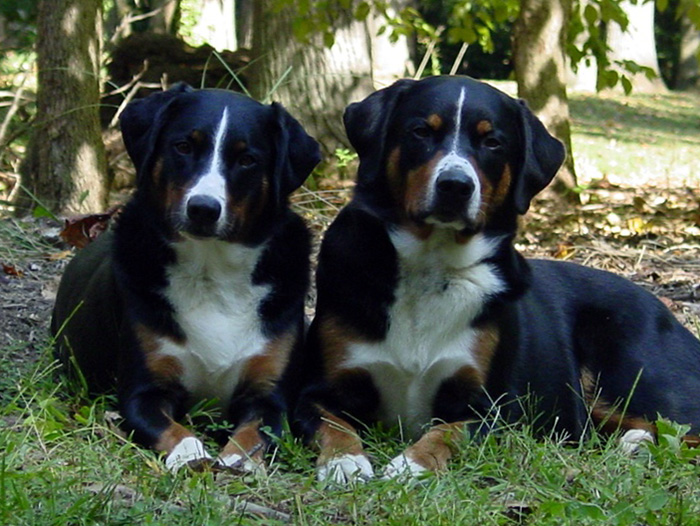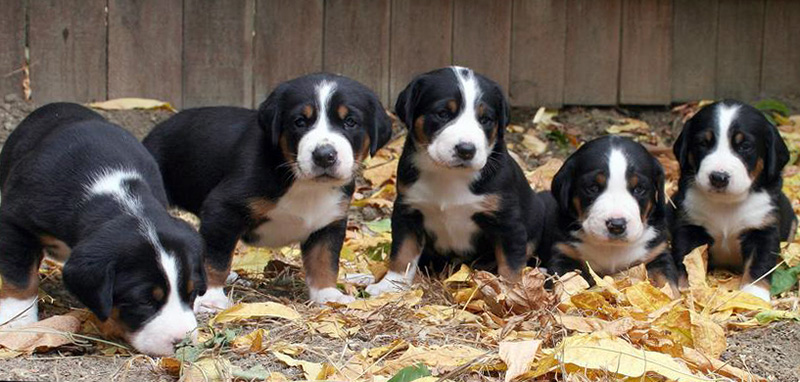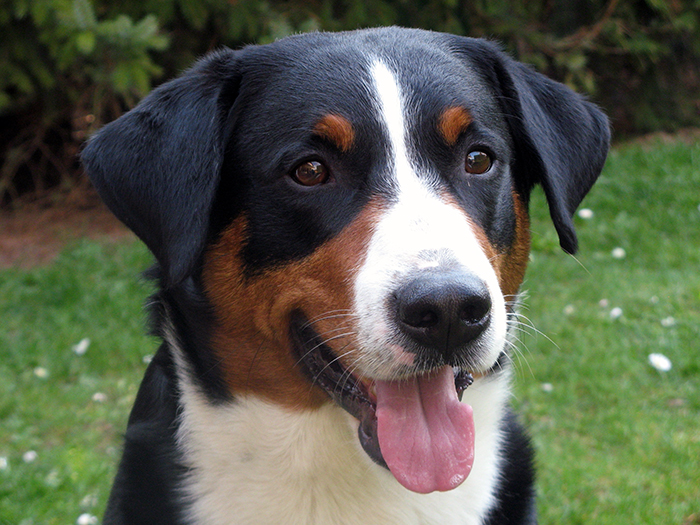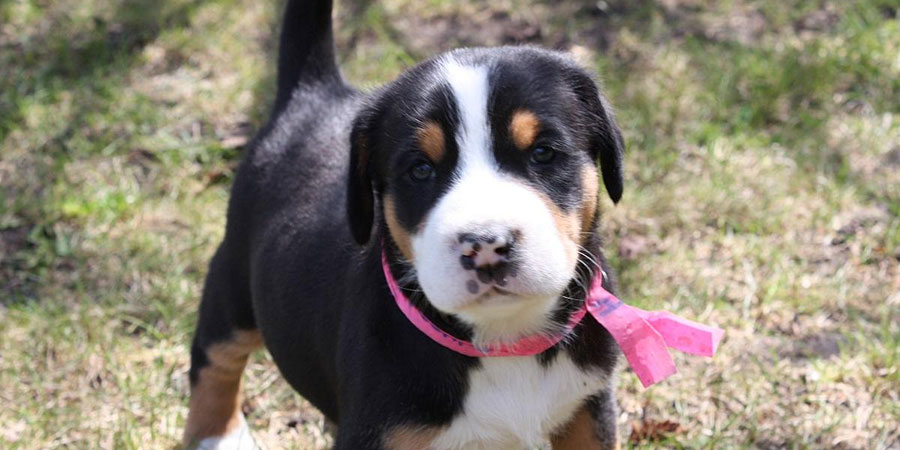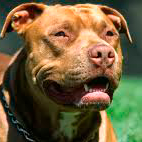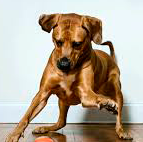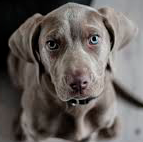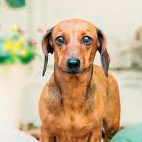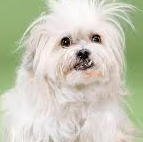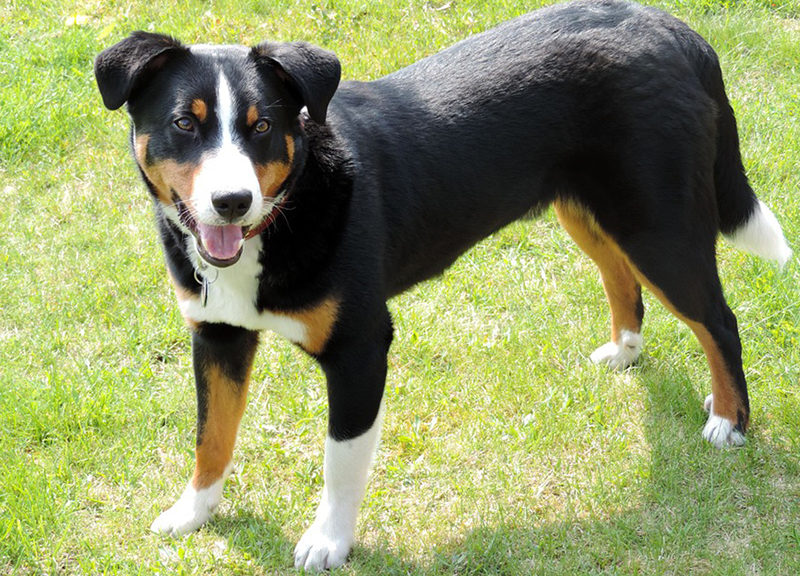
Appenzeller Sennenhund
Appenzeller Sennenhund pictures ➜
ORIGIN: Switzerland
UTILIZATION
Driving, watch, guard, house and farm dog. Today also a versatile working and family dog.
BRIEF HISTORICAL SUMMARY
In 1853 an Appenzeller Mountain-Dog was first described in the book “Tierleben der Alpenwelt” (Animal Life in the Alps) as “a clearly barking, short haired, medium size, multicolour cattledog of a quite even “Spitz type”, which can be found in certain regions and is used partly to guard the homestead, partly to herd cattle”. In 1898 the Appenzeller Sennenhund was designated a separate breed. The first breed standard was confirmed with the collaboration of the breed’s great promoter, head forester Max Siber and the breed was introduced with eight dogs at the first International Dog Show held in Winterthur. Thanks to the instigation of Professor Dr. Albert Heim, who was greatly concerned with Swiss Cattledogs and with them the Appenzeller, the Appenzeller Sennenhund Club was founded in 1906. Its purpose was to preserve and promote the breed in its natural state. With the compulsory registration of puppies in the “Appenzeller Dog Stud Book”, the aim of pure breeding was begun.
The original breeding territory was the Appenzell region. Today the breed is distributed all over Switzerland and beyond its borders and bred in many European countries. The notion “Appenzeller Sennenhund” is clearly outlined nowadays and the breed, as such, quite distinct from other Swiss Cattledogs. Although the Appenzeller Mountain-Dog has found many admirers, the breeding stock is still very small. It is only by responsible and careful breeding that it will be possible to establish and consolidate its natural and outstanding hereditary qualities.
GENERAL APPEARANCE
Tricolour, medium size, almost squarely built dog, balanced and even in all parts. Muscular, with a cheeky expression.
IMPORTANT PROPORTIONS
Height at withers to length of body = 9 : 10. More compact than long.
Length of muzzle to length of skull = 4 : 5.
BEHAVIOUR/TEMPERAMENT
Lively, high spirited, self assured, reliable and fearless. Slightly suspicious of strangers. A watchdog which cannot be bribed, cheerful and capable of learning.
HEAD
Balanced size in relation to body. Slightly wedge shaped.
CRANIAL REGION Fairly flat, broadest between the ears, tapering evenly towards the muzzle . Occiput barely pronounced . Frontal furrow moderately developed. Stop slightly marked. Cheeks barely pronounced.
MUZZLE: Medium strength, tapering evenly, with strong lower jaw.
NOSE:
In black dogs: black.
In havana brown dogs: brown.
FLEWS: Clean and close fitting, black or brown pigment respectively.
TEETH: Strong, complete and regular scissor bite. Pincer bite tolerated. One missing PM1 or double PM1 (Premolar 1) and missing M 3 (Molar 3) tolerated.
EYES
Rather small, almond shaped, not protruding. Set slightly oblique towards the nose. Expression lively.
Colour: In black dogs: dark brown, brown.
In havana brown dogs: lighter brown but as dark as
possible.
Eye lids: Close fitting. Pigment black, respectively brown (as dark as possible).
EARS: Set on fairly high and broad, hanging down flat and close to cheeks in repose. Triangular shape with tips rounded off. In alertness raised at set on and turned forward so that the head and ears, seen from above, form a marked triangle.
NECK: Medium length, strong and clean.
BODY: Compact, substantial.
BACK: Moderately long, strong and straight.
RUMP: Short; running in a straight continuation of the topline.
CHEST: Broad, deep, reaching to the elbows with definite fore chest. Sternum reaching sufficiently far back. Ribcage round -oval in diameter.
LOINS: Short and well muscled.
BELLY: Only slight tuck up.
TAIL: Set on high, strong, of medium length, profusely coated. Hair slightly longer on underside. In movement carried tightly curled over croup, carried sideways or in centre.
LIMBS: Strong bone.
FOREQUARTERS
General: Well muscled. Forelegs seen from front straight and parallel, standing not too narrow..
Shoulder: Shoulderblade long and sloping.
Upper Arm: Same length or only slightly shorter than shoulderblade. Angle with shoulderblade not too blunt. Elbows close fitting.
Forearm: Straight, lean.
Pastern: Seen from front forms a straight line continuation of the forearm. Seen from the side, set at very light angle.
Forefeet: Short, arched and tight.
HINDQUARTERS
General: Well muscled. Seen from rear, hindlegs straight and parallel, standing not too narrow.
Upper thigh:Fairly long. Forming an open angle to the lower thigh, in balance with forehand angulation.
Lower thigh: Equally long or only slightly shorter than the upper thigh. Angle to upper thigh not too blunt. Lean and well muscled.
Hock joint: Set relatively high.
Hock: VParallel in position, turning neither in nor out. Dewclaws must be removed.
Hindfeet:Short, arched and tight.
MOVEMENT: Good rear drive, well reaching stride in front. Seen from either front or rear, limbs move in a straight line.
COAT
Double coat (“Stockhaar”): Firm and close fitting.
Hair: Top coat thick and shiny. Undercoat thick, black, brown or grey. It is undesirable for the undercoat to be visible through the top coat. Slightly wavy coat on withers and back tolerated but undesirable.
Colour and markings
Basic colour black or havana brown with symmetrical rust-red (tan) and white markings.
Small tan spots over eyes. Tan markings on cheeks, chest (left and right in region of shoulder – upper arm joint) and on legs. The tan on the latter must invariably be located between the black, or havana brown and the white.
White markings: distinct white blaze which runs from the cranial region without break over the bridge of the nose and can reach totally or partially round the muzzle. White from chin, covering throat without break to chest . White on all four feet. White on tip of tail.
White spot on nape of neck or half collar round neck tolerated. Thin white ring all round neck tolerated but not desirable.
SIZE
Desired Height at Withers: Dogs: 52 – 56 cm 50 – 58 cm tolerated.
Bitches: 50 – 54 cm 48 – 56 cm tolerated.
FAULTS
Any departure from the foregoing points should be considered a fault which should be penalised in proportion to its seriousness and importance.
- Lack of sexual evidence
- Under- or oversize
- Too long or unbalanced in body
- Too heavy or too light in head
- Skull too round (apple head)
- Stop too defined
- Muzzle too long, too short, narrow or pointed; Roman nose
- Flews too developed
- Absence of teeth other than 1 PM 1 (first premolar)
- Cheeks too prominent
- Eyes round, protruding or too light
- Entropion, ectropion
- Ears too small, too large, standing off; set on too high or too low
- Swayback, roach back, overbuilt rump
- Belly tucked up
- Flat or barrel-shaped chest, absence of forechest, sternum too short
- Down in pasterns
- Feet longish-oval (hare-feet), splay feet
- Out at elbows
- Insufficient angulation of fore- and hindquarters
- Cow-hocked
- Sickle tail
- Incorrect movement, e.g. short stilted gait, narrow movement coming and going, weaving etc.;
- Faults in marking:
- black ticks on white
- broken blaze
- broad white collar around the whole neck
- divided white on chest
- white reaching distinctly above pastern (“boots”)
- Weak temperament, absence of liveliness, aggressiveness
DISQUALIFYING FAULTS
- Wall eye
- Tail distinctly hanging down, kinky tail.
- Other than double coat (Stockhaar).
- Other than tricoloured coat.
- Other than black or havana-brown main colour.
N.B.: Male animals should have two apparently normal testicles
fully descended into the scrotum.


